Tayabas City
- "City of Festivals"
- "Home of The Finest Lambanog"
- "Rest and Recreation Destination of Quezon"
- "City of 11 Spanish Bridges"
- "Old Capital of Tayabas Province"
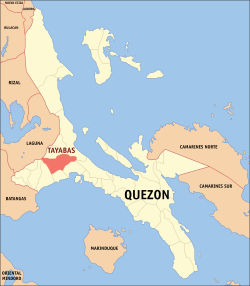
Tayabas, officially the City of Tayabas (Filipino: Lungsod ng Tayabas), is a component city in the province of Quezon, Philippines. According to the 2020 census, it has a population of 112,658 people.
The city is known for various historical landmarks like ancestral houses, more than twenty Spanish colonial stone bridges, 16th century stone crosses believed to be abodes of nature spirits, festivals, and local delicacies like lambanog and various desserts, alongside resorts and rest and recreation facilities. It was the former capital of Quezon (then named Tayabas). The prevalent architectural sites of the city, including its bridges, has led numerous scholars to campaign its inclusion in the UNESCO World Heritage List.
Sociologist Rolando V. Redor advanced that the name Tayabas was suggested because of the abundance of ferns called ''tagabas''.
According to one reference, Tayabas may come from the word ''tayaban''. Tayaban is a night creature known for having wings that glow like tropical fireflies.
From the dialect of Tayabas Tagalog, there is also the word ''tayaba'', which is an indigenous practice of the igba for planting.
One of the popular theories for the origin of the name Tayabas is that it comes from the word ''bayabas'' (guava), but the said fruit is not native to the Philippines.
Tayabas is at the center of the province's long-settled heartland, which possessed the best lands, the oldest parishes, and the most active commercial centers. The provincial heartland was later described by Manuel L. Quezon as having the "richest and gayest places in the province."
In 1578, Fray Juan de Plasencia and Fray Diego de Oropesa, two Franciscan missionaries from Spain founded the town of Tayabas in order to spread Christianity to its natives. Prior to the occupation, however, the native Tayabenses lived in rural settlements (barangay) typical of those times, headed by chiefs and a council of elders. During this time, ancestral stones and rocks that the people believed to be abodes of nature spirits were turned to stone crosses due to the influx of Christianity. They exist up to this day, however, many have been stolen, uprooted, sold and destroyed due to the belief of foreign treasure hunters that each cross contains treasures.
Historians and archaeologists have disproved these claims by treasure hunters and have found no treasure in any archaic stone crosses in Tayabas. The destruction and uprooting of these crosses has "endangered the stone cross tradition of Tayabas." By the end of the 1700s, Tayabas had 7,396 native families and 12 Spanish Filipino families.
From 1605 to 1901, Tayabas was the capital of the Province of Tayabas, now known as Quezon. In the 19th century, Tayabas was among the biggest towns in the country. Its Minor Basilica of St. Michael the Archangel, which was enlarged in the mid-1850s, is the longest church in the country and is a lasting testament to its glorious and historic past.
In more than three centuries of Spanish occupation, only eight cities and towns were given the title of Villa, and Tayabas was one of them. These are La Villa del Santisimo Nombre de Jesus de Cebu in 1565, La Villa de Santiago de Libon (Albay, 1573), La Villa Fernandina de Vigan (Ilocos, 1574), La Villa Rica de Arevalo (Iloilo, 1581), La Noble Villa de Pila (Laguna, 1610), La Muy Noble Villa de Tayabas (Tayabas, 1703), La Villa de Bacolor (Pampanga, 1765), La Villa de Lipa (Batangas, 1887). While the others were conferred the title of noble villas, Tayabas was given the status of 'most noble' villa.
In the book The Philippines, written by French traveler Jean Baptiste Mallat, and published in 1846, it appears that Tayabas had more than 21,000 people at that time. This was reduced to 16,000 when Lucena became an independent town in 1879. Due to low population growth during the Spanish period, this number remained unchanged until the coming of the Americans.
Casa Comunidad, a centuries-old building, is the place where Apolinario "Hermano Pule" Dela Cruz was tried and sentenced to death in 1841. It was restored in the 1990s through funds donated by the Friends of Casa Comunidad, an organization of affluent Manila-based Tayabenses.
During the Philippine Revolution, a Spanish garrison occupying the massive church and convent buildings was besieged by Miguel Malvar's forces. The siege lasted 3 months, spanning from 24 June 1898 to 13 August 1898. The siege would end when the Spanish garrison unconditionally surrendered to Malvar's forces.
Tayabas features numerous Spanish-era bridges which mirror its rich architectural past and serve as crucial connections to the city. Two of the longest bridges in Tayabas are the Malagonlong Bridge and the Malaoa bridges. During the second world war, Imperial Japanese Forces rapidly advanced toward the city, forcing the locals to rush fortifications. In a bid to slow the Japanese forces down, the locals planted explosives underneath the Malagonlong Bridge. The plan to destroy the bridge however was unsuccessful as the explosives failed to destroy the bridge. This can be attributed to the bridge's design, which was made to be extremely durable. Malagonlong Bridge was later declared a national historical site.
Later on in the war, the city of Tayabas became the target of small bombing runs from enemy forces. It again suffered a terrible blow near the end of World War II when it was completely burned to the ground after a bombing raid on 15 March 1945. Prior to that, the old houses of Tayabas rivaled those of Vigan's Spanish-era structures.
The local resistance continued their efforts to fight the Japanese all the way to when American Liberation forces and the Philippine Commonwealth troops finally secured the area.
On July 14, 2007, the municipality held a plebiscite to ratify the conversion of the said act, with the residents voting in favor of the move, although there was a low turnout of voters for the plebiscite.
The Supreme Court declared the cityhood law of Tayabas and 15 other cities unconstitutional after a petition filed by the League of Cities of the Philippines in its ruling on November 18, 2008. On December 22, 2009, the cityhood law of Tayabas and 15 other municipalities regain its status as cities again after the court reversed its ruling on November 18, 2008. On August 23, 2010, the court reinstated its ruling on November 18, 2008, causing Tayabas and 15 cities to become regular municipalities. Finally, on February 15, 2011, Tayabas becomes a city again including the 15 municipalities declaring that the conversion to cityhood met all legal requirements.
After six years of legal battle, in its board resolution, the League of Cities of the Philippines acknowledged and recognized the cityhood of Tayabas and 15 other cities.
Tayabas is 9 kilometers (5.6 mi) from Lucena and 139 kilometers (86 mi) from Manila and it is accessible by land from Metro Manila passing through Rizal and Laguna east via Manila East Road or via South Luzon Expressway.
Tayabas is politically subdivided into 66 barangays. Each barangay consists of puroks and some have sitios.
| Climate data for Tayabas (1991–2020, extremes 1970–2023) | |||||||||||||
|---|---|---|---|---|---|---|---|---|---|---|---|---|---|
| Month | Jan | Feb | Mar | Apr | May | Jun | Jul | Aug | Sep | Oct | Nov | Dec | Year |
| Record high °C (°F) | 32.5 (90.5) |
32.5 (90.5) |
33.5 (92.3) |
36.0 (96.8) |
36.0 (96.8) |
35.5 (95.9) |
34.6 (94.3) |
35.6 (96.1) |
35.5 (95.9) |
35.0 (95.0) |
34.0 (93.2) |
32.4 (90.3) |
36.0 (96.8) |
| Mean daily maximum °C (°F) | 27.8 (82.0) |
28.4 (83.1) |
29.9 (85.8) |
31.8 (89.2) |
32.5 (90.5) |
31.9 (89.4) |
31.1 (88.0) |
31.2 (88.2) |
31.1 (88.0) |
30.4 (86.7) |
29.4 (84.9) |
28.2 (82.8) |
30.3 (86.5) |
| Daily mean °C (°F) | 24.8 (76.6) |
25.1 (77.2) |
26.2 (79.2) |
27.7 (81.9) |
28.3 (82.9) |
28.0 (82.4) |
27.4 (81.3) |
27.4 (81.3) |
27.2 (81.0) |
26.8 (80.2) |
26.3 (79.3) |
25.4 (77.7) |
26.7 (80.1) |
| Mean daily minimum °C (°F) | 21.8 (71.2) |
21.8 (71.2) |
22.6 (72.7) |
23.7 (74.7) |
24.2 (75.6) |
24.0 (75.2) |
23.6 (74.5) |
23.5 (74.3) |
23.2 (73.8) |
23.3 (73.9) |
23.3 (73.9) |
22.6 (72.7) |
23.1 (73.6) |
| Record low °C (°F) | 17.5 (63.5) |
16.8 (62.2) |
17.9 (64.2) |
18.3 (64.9) |
20.6 (69.1) |
21.0 (69.8) |
18.9 (66.0) |
19.3 (66.7) |
19.4 (66.9) |
19.4 (66.9) |
18.6 (65.5) |
18.7 (65.7) |
16.8 (62.2) |
| Average rainfall mm (inches) | 165.2 (6.50) |
132.8 (5.23) |
109.6 (4.31) |
99.5 (3.92) |
159.7 (6.29) |
215.3 (8.48) |
273.1 (10.75) |
186.4 (7.34) |
271.6 (10.69) |
452.0 (17.80) |
545.2 (21.46) |
534.3 (21.04) |
3,144.7 (123.81) |
| Average rainy days (≥ 1 mm) | 16 | 12 | 9 | 7 | 12 | 14 | 17 | 15 | 16 | 19 | 22 | 22 | 181 |
| Average relative humidity (%) | 86 | 85 | 84 | 81 | 82 | 84 | 85 | 85 | 86 | 86 | 87 | 87 | 85 |
| Source: PAGASA | |||||||||||||
| Year | Pop. | ±% p.a. |
|---|---|---|
| 1903 | 14,740 | — |
| 1918 | 14,983 | +0.11% |
| 1939 | 18,172 | +0.92% |
| 1948 | 16,989 | −0.75% |
| 1960 | 25,758 | +3.53% |
| 1970 | 35,166 | +3.16% |
| 1975 | 37,756 | +1.44% |
| 1980 | 42,137 | +2.22% |
| 1990 | 54,355 | +2.58% |
| 1995 | 64,449 | +3.24% |
| 2000 | 70,985 | +2.09% |
| 2007 | 87,252 | +2.89% |
| 2010 | 91,428 | +1.72% |
| 2015 | 99,779 | +1.68% |
| 2020 | 112,658 | +2.42% |
| Source: Philippine Statistics Authority | ||

Poverty incidence of Tayabas
2.5
5
7.5
10
12.5
15
2006
12.40 2009
10.48 2012
9.55 2015
8.75 2018
6.26 2021
12.88 Source: Philippine Statistics Authority |
The major agricultural products of Tayabas are rice and coconut. It is also known for sweet delicacies, budin (cassava cake) and lambanog.
Tayabas is rich in history as it was the capital of Tayabas Province (Now in Quezon) during Spanish era. There are falls, caves, river, and hills/mountains to discover.

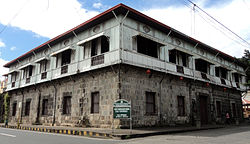
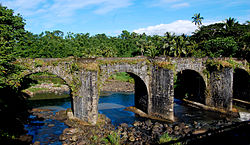
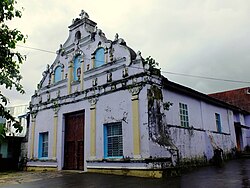
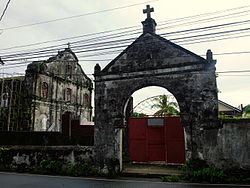
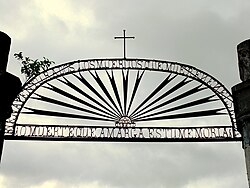
Mayohan sa Tayabas
Tayabas is also known for the annual Mayohan sa Tayabas (San Isidro Festival), celebrated every month of May. This is a harvest festival honoring San Isidro Labrador, the patron saint of farmers. The festival is a significant event for the people of Tayabas, as it showcases their rich cultural heritage, promotes tourism in the area, and pays homage to the local farmers who have been the lifeblood of Tayabas' economy for generations.
This festival usually opens at the beginning of the month with a Parada ng Baliskog. Baliskog, the local term for welcome arch, is usually made of indigenous materials such as coco leaf, coco husk, bamboo poles, buli, rattan, dried flowers, tistis and other decors such as local flowers, corn, and palay. The parade also includes tao-tao, a local term for scarecrows used by farmers on their farms. A Parada ng Tagay is also included in the welcoming parade to promote Lambanog, the proudest product of the town. This parade is participated by some members of different barangays and also by various organizations and barangay associations.
The main highlight of this festivity is the procession of the image of San Isidro Labrador, which is held every May 15. It passes through the town center, where houses are decorated with pabitin, kiping, crops, and other indigenous materials. Men accompanying the procession will participate in Hagisan ng Suman, in which massive amounts of suman will be thrown at the crowd. Suman is considered a ritual gift by the Tayabasin people. It is believed that it will bring prosperity and luck. An estimate of at least 12,000 pieces of suman are thrown every Mayohan Festival. The pabitin, which are tied with suman and other summer fruits like banana, pineapple, buko, and mango, will be emptied as soon as the image of San Isidro Labrador passes by.
Jeepneys and tricycles are common options when travelling to destinations within the downtown and the city.
To ease the traffic situation in Tayabas, the San Miguel Corporation will build a 66.74 km extension of South Luzon Expressway, also known as SLEX-TR4.
{{cite journal}}: Cite journal requires |journal= (help)